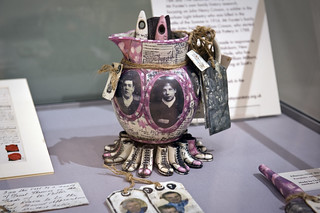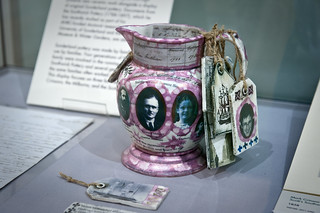When I heard that What’s Your Story? Discovering Family History, a Tyne & Wear Archives & Museums travelling exhibition, was coming to Sunderland Museum & Winter Gardens (SMWG), I was keen to get involved. As an artist working with this venue’s collection of Sunderland pottery, I was interested to use this opportunity to explore links between the collection and the wider community of Sunderland through my creative ceramics practice.
In a previous exhibition, Kith and Kin: New Glass and Ceramics, held at the National Glass Centre earlier in the year, I had curated a cabinet of original Sunderland pottery alongside documents from the ‘Scott archive’, a collection of paper ephemera from the Southwick Pottery (1788-1897) I had re-accessioned as part of my research. Addressing the title of the exhibition, my display aimed to highlight the family aspect of the production and consumption of Sunderland pottery, demonstrating through objects how it had often been made by several generations of the same families. I also wanted to show how it had been used to commemorate and celebrate family events like births, deaths and marriages. New ceramic work, made in collaboration with members of the Sunderland community, was also displayed in order to establish a dialogue between the past and the present, exploring how ceramic objects have and can be used to commemorate personal and wider narratives.
As discussed in a previous blog, Howard Forster, a visitor to the exhibition, recognising some of the documents in my display from his own family history research, contacted me and we decided to make a new object which celebrated his family history through reference to his ancestors’ involvement in the Sunderland potteries. My blog about the Crinson Jug, led to an e-mail enquiry from Sally Hyde, a British-born, New Zealand-based occupational therapist whose fourth great-grandfather, William Milburn, had also been a master potter at Southwick Pottery. Further investigation of the ‘Scott Archive’ revealed a letter addressed to the Durham Agricultural Society dated 1845 showing that William started working at Southwick Pottery in 1788 and continued for 57 years. Milburn would have been a contemporary of William Crinson and his son, Robert, who started working at Southwick in 1788 and 1817 respectively.
For my contribution to the What’s Your Story exhibition, I decided to make a further jug to celebrate this connection as well as Sally’s quest to trace her family tree. This jug, which utilises much imagery collected by Sally on her ‘journey’ has been displayed in a desk case alongside the Crinson Jug and associated archive materials relating to the Milburns and Crinsons, including the above letter, Mark Crinson’s indenture and a letter from Robert Crinson, Mark’s nephew and William’s great grandson. The Crinson Jug has been ‘updated’, by the addition of ceramic labels printed with photographs of Howard Forster, his son and grandson. Interesting for me was the process of making the Milburn Jug which was negotiated remotely through e-mail correspondence and access to Sally’s Ancestry.com guest account. Sally has written a story about her own family history research which can be viewed on the What’s Your Story? website.
How an engagement with creativity, whether it results from tracing one’s family tree or crafting new objects, can help to define one’s identity and sense of self, a theme which has emerged through my recent ceramic practice, also appears to be a wider concern within academia and society. This is well illustrated by Sally’s experience of tracing her family history which seems to have helped her to cope with living far away from her family roots:
I was living in New Zealand and the whole process of creating the next generation started me thinking, and wanting to know about who had gone before. I have lived in New Zealand since 1986; I often feel the distance and a loss in so far as hearing family stories and family information, and this became more acute after the birth of my daughter. We visited my parents in the UK in 2000 and together with my mother began to investigate the past.
Similarly, an ability to empathise with her potter ancestor has helped to guide her own pursuit of making and collecting ceramics:
The knowledge of a Master Potter in my ancestry was great news to me as I have been working at an adolescent mental health unit as an Occupational Therapist for two years since my return to New Zealand in 2010. I have discovered a keen interest in pottery. My work is of a very amateur level, but I like to think that William guides me, and that my DNA assists too.
I don’t have any knowledge of what pieces of pottery William Milburn was involved in creating. I would love to have more information, but am not sure how to obtain this information or even know if it is obtainable. I have since purchased some Sunderland lustre ware pieces of pottery and would like to add more to my collection. I am especially interested in the pieces with a nautical theme which, for me, is inspired by my ancestors that follow from William Milburn who were sea farers. There is a family tendency to sail to foreign shores.
My intention with both jugs was to use relatively ephemeral information from digital photographs and scanned original documents to create enduring, dramatic material focal points or ‘micro-sites’ for commemoration and reflection. Family histories are often lost or not fully passed down the generations. These jugs are attempts to explore how ceramics can be used to preserve such fragile histories through a creative articulation of past and present. The degree to which translating Sally’s and Howard’s research into material objects has helped them to reflect upon their personal histories and how engaged they have felt in the creative process are perhaps questions I can reflect upon as part of my research.
What’s Your Story? offers an example of how museums can respond to the grassroots preoccupations of their visitors, empowering them to frame their own histories through the creation of dialogues between personal stories and items in the collection. The role the craft practitioner can play in the encouragement and mediation of this creativity, especially with reference to a collection, provides rich potential for innovative research. The combination of object making activities and museum display with digital participatory media leads to the possibility of the collection, the community and the artist being linked virtually as well as materially.
Did any of your ancestors work in the Sunderland potteries? Do you own or collect Sunderland pottery or do you know someone who does? If so, we’d love to hear from you.
Read more about the Crinson and Milburn families on the What’s Your Story? website: www.whatsyourstory.org.uk. What’s Your Story? Discovering Family History runs until the 27th August, 2012 at the Sunderland Museum & Winter Gardens.
Christopher McHugh is an AHRC Collaborative Doctoral Award PhD student based at the University of Sunderland and Sunderland Museum & Winter Gardens. Read more about his project at www.communityinclay.org.uk.


8 Responses to What’s Your Story? Discovering Family History – The Milburn Jug